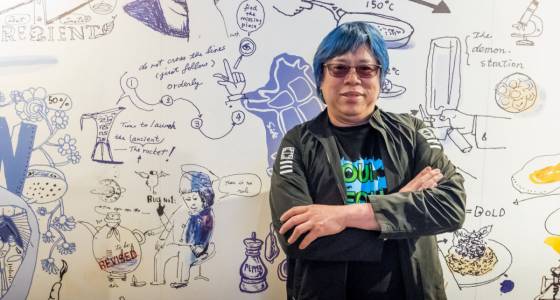HONG KONG-“It’s not that hard to make good food,” claims Alvin Leung, chef-owner of Bo Innovation: The Hong Kong Story.
“There are tools, better ingredient selection . . . but you have to go beyond that to get three Michelin stars,” the MasterChef Canada judge explains, a nod to the status he shares with five others in a metropolis with 11,000 restaurants.
“Your food has to be special.”
When it comes to Hong Kong gastronomy, most imagine tables casually strewn with glistening platters of wok-tossed noodles, mouth-watering siu mei (Chinese barbecue), and steaming bamboo baskets of dim sum.
Related story:6 places to explore in Hong Kong
The quintessential choice might still be cheap-and-cheerful dai pai dongs (street stalls), cha chaan tengs (Hong Kong-style diners) or al fresco seafood feasts, but there’s an international food scene here that has been heavily decorated by the world’s best guides.
Hong Kong’s progressive dining scene is exemplified at the newest iteration of Bo Innovation. The Demon Chef has given classic Cantonese dishes an “x-treme” makeover: from a whimsical starter featuring known street foods as Aeroplane Chess pieces (a loved childhood game) to Leung’s signature wrapper-less soup dumpling, each dish is a part of Leung’s Hong-Kong narrative.
“I like using iconic things. What fine dining restaurant can get you to eat a breakfast sandwich that’s like baby food?” Leung teases, referencing his cheeky custard course that’s served in a custom-labelled baby-food jar but “is enhanced with black truffles, butter croutons, and spam foam.”
According to food writer, social entrepreneur and friend Janice Leung Hayes, Hong Kongers love twists on the familiar. “They’re also becoming more educated about food, and are keen to try new things.”
Dim sum is a popular muse. Yum Cha’s version caters to health-conscious eaters, using organic or properly sourced ingredients, and topping their Chinese (insert buzzword) kale salad with pomegranate seeds.
Reports by the World Bank show Hong Kong as having one of the highest per capita incomes. A major centre of international trade, the port city is constantly exposed to different cultures, their cuisines and styles of cooking.
Hong Kong is the fourth most densely populated region in the world. The soaring cost of housing means the growing segment of affluent young consumers are finding more satisfaction spending their disposable income instead of saving to buy a place to live.
“There are always opportunities for new restaurants regardless of real-estate prices,” says Tze-Huei Choo, Duddell’s general manager. “Competition is high, but it will always work if you have the right concept.” It’s the winning formula exercised by parent company JIA Group, whose impressive collection of high-profile restaurants includes two Michelin-star christened Duddell’s, that garners as much attention for its fine Cantonese cuisine as for its rotating art exhibitions.
“Homes are small, so the need to eat out won’t change,” says Vicky Cheng, chef-partner of VEA. “In some ways it’s actually cheaper: a $12 bowl of wonton noodles saves you from buying, sourcing, cooking and cleaning. So it makes sense.”
At Cheng’s newly Michelin-minted restaurant, the Toronto- and New York-trained chef prepares a thoughtful French menu using flavours from the Chinese pantry.
The merit of ranking surveys might be controversial, but for restaurants such as two-starred Ta Vie, being named on Asia’s Best 50 list is one way to attract guests looking for a non-Chinese option. Hong Kong’s location gives chef-owner Hideaki Sato greater access to imported ingredients needed for the former Ryugin chef’s beautiful French-Japanese dishes, plus exposure to well-travelled diners.
“Michelin is the epitome of restaurant standards, and has a certain rank within the restaurant community,” Choo continues. “Consumers are all about perception; it affects business if you have one, two or three stars.”
Leung Haynes elaborates: “Food is in some ways about status, even more so now with social media. So young people are finding value in memories or in the ability to say you had it on Instagram.”
Hong Kong is now the world’s fifth largest wine-consuming market. It’s serious enough that this past year’s Wine & Dine FestivalWine & Dine Festival, Asia’s largest culinary event, saw more than 280 global winemakers keeping 145,000 attendees refreshed.
“Hong Kong never had prestige,” says Leung, referencing the former British colony’s pre-entrepôt days.
“It’s gone from fishing village to where it is today. Wine provides the ‘nouvelle rich’ an outlet of sophistication and investment. So if you’re going to be extravagant, what better or easier way than with food and wine?”
Renée S. Suen was hosted by the Hong Kong Tourism Board, which didn’t review or approve this story.
Renée S. Suen was hosted by the Hong Kong Tourism Board, which didn’t review or approve this story.
When you go
Get there:Cathay Pacific (cathaypacific.com) flies daily from Toronto to Hong Kong. Get a head start after an overnight flight with a shower at one of Cathay’s six lounges in Hong Kong, including the newest addition, The Pier, which also features beds, if you want to take a nap, and a wide selection of refreshments from a fully stocked tea and noodle bar. The Airport Express can take you directly to the central business district in less than 25 minutes.
Season: Year-round, but September and early December is best.
Get around: The city’s Mass Transit Railway (MTR) is a quick and efficient means of moving across most of the districts and New Territories. Purchase a prepaid Octopus Card (octopus.com.hk) at any station and use it on the MTR, buses or minibuses. Taxis are relatively inexpensive, easily hailed, and are colour coded to the area of operation: red (Hong Kong and Kowloon), green (New Territories), and blue (Lantau Island). Note: Passengers are responsible for the tolls charged on cross-harbour trips.
Stay: If staying on the Hong Kong Island, consider Hotel Jen by Shangri-La (hoteljen.com/hongkong/westerndistrict/about/ ) that’s just steps away from the new HKU station in the Western District. The rooms are bright and comfortable, and it’s home to Bib Gourmand restaurant Café Malacca, which serves tasty Malaysian and Singaporean cuisines. I also stayed at Hotel Stage (hotelstage.com) in Kowloon, a boutique and business hotel near Jordan station. Here, functional creative spaces and contemporary comforts meet art, culture and history. Rooms are decked out with multimedia connectivity, while both in-house Kitchen Savvy restaurant and The Muse wine bar are thoughtful and impressive.
Do your research:discoverhongkong.com
The Toronto Star and thestar.com, each property of Toronto Star Newspapers Limited, One Yonge Street, 4th Floor, Toronto, ON, M5E 1E6. You can unsubscribe at any time. Please contact us or see our privacy policy for more information.
Our editors found this article on this site using Google and regenerated it for our readers.












